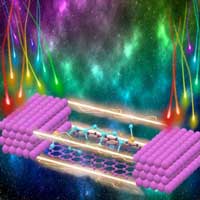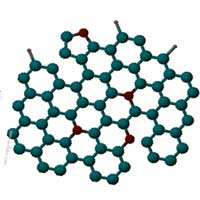 Carbon nanotube technology may boost 5G and mm-wave technologies, improving military communications and sensing equipment.
Carbon nanotube technology may boost 5G and mm-wave technologies, improving military communications and sensing equipment.
Thursday, November 21, 2019
Carbon nanotube project may improve military communications by boosting 5G technology
 Carbon nanotube technology may boost 5G and mm-wave technologies, improving military communications and sensing equipment.
Carbon nanotube technology may boost 5G and mm-wave technologies, improving military communications and sensing equipment.
Breaking (and restoring) graphene's symmetry in a twistable electronics device
 Researchers invent a new way to tune the properties of 2D materials by adjusting the twist angle between them; technology enables the development of nanoelectromechanical sensors with applications in astronomy, medicine, search and rescue, and more.
Researchers invent a new way to tune the properties of 2D materials by adjusting the twist angle between them; technology enables the development of nanoelectromechanical sensors with applications in astronomy, medicine, search and rescue, and more.
Big plans to save the planet depend on nanomaterials improving energy storage
 A new report lays out how research in the field of nanomaterials for energy storage over the last two decades has enabled the big step that will be necessary to make use of sustainable energy sources.
A new report lays out how research in the field of nanomaterials for energy storage over the last two decades has enabled the big step that will be necessary to make use of sustainable energy sources.
Magnetic wave flows under better control from now on
 Even faster processors with even smaller dimensions? Wherever neither electronics nor spintronics can cope with performance or miniaturization, magnonics comes to the rescue. But before that happens, scientists must learn how to accurately simulate the flow of magnetic waves through magnonic crystals.
Even faster processors with even smaller dimensions? Wherever neither electronics nor spintronics can cope with performance or miniaturization, magnonics comes to the rescue. But before that happens, scientists must learn how to accurately simulate the flow of magnetic waves through magnonic crystals.
A review of single molecule-based electronic devices
 The authors of this review provide an overview of single molecule electronic devices, including molecular electronic devices and electrode types. Future challenges to the development of electronic devices based on single molecules are described, in the hopes of attracting more experts from different fields to participate in this research.
The authors of this review provide an overview of single molecule electronic devices, including molecular electronic devices and electrode types. Future challenges to the development of electronic devices based on single molecules are described, in the hopes of attracting more experts from different fields to participate in this research.
Graphene-based nanoplatforms for chemotherapy
 In a review paper, scientists systematically discuss the recent progresses, current challenges and future perspectives of smart graphene-based nanoplatforms for synergistic tumor therapy and bio-imaging.
In a review paper, scientists systematically discuss the recent progresses, current challenges and future perspectives of smart graphene-based nanoplatforms for synergistic tumor therapy and bio-imaging.
Researchers find a glitch in methods used to synthesize graphene and other 2D materials
 Scientists have stumbled upon an unexpected phenomenon that would have significant implications on the existing protocols followed to synthesize graphene and other two dimensional (2D) nanomaterials.
Scientists have stumbled upon an unexpected phenomenon that would have significant implications on the existing protocols followed to synthesize graphene and other two dimensional (2D) nanomaterials.
Subscribe to:
Posts (Atom)
